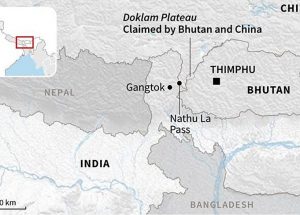September 12, 2017
 EXECUTIVE SUMMARY: On July 24, 2017, China warned India “not to push its luck” – the latest salvo in a long-running border conflict. India wants the Chinese to stop construction of a road to the “chicken’s neck”: the Doklam plateau in the Himalayan mountain ridge between China and the Kingdom of Bhutan, India’s close ally. This narrow strip of land connects China to northeastern India. The Chinese road, if completed, could ultimately threaten India and would represent a major strategic advantage for the Chinese.
EXECUTIVE SUMMARY: On July 24, 2017, China warned India “not to push its luck” – the latest salvo in a long-running border conflict. India wants the Chinese to stop construction of a road to the “chicken’s neck”: the Doklam plateau in the Himalayan mountain ridge between China and the Kingdom of Bhutan, India’s close ally. This narrow strip of land connects China to northeastern India. The Chinese road, if completed, could ultimately threaten India and would represent a major strategic advantage for the Chinese.
In 1890, the British Mandate ruling India and representatives of the Chinese Qing dynasty signed an agreement to partition the Tibetan and Sikkim regions, which are adjacent to the Doklam plateau region. The agreement was not sufficiently comprehensive, leaving some areas claimed by both sides.
Decades later, in 1962, after India had gained independence and with China now ruled by the Communist party, war broke out between the two sides. Although it only lasted about a month, this war was deeply engraved in the collective memories of both nations. The war broke out over a border dispute very similar to the one raising tensions today.
In 2005, China and India signed a draft agreement that included guidelines and parameters for a final agreement regarding the shared border, but the area remains unsettled.
The Doklam plateau is not the only border issue in East Asia. Other problem areas (among many) include the Spratly and Paracel Islands in the South China Sea, which are disputed by all their neighboring states; the Senkaku Islands, which are disputed by Japan and China; and the Amur River County on the Chinese-Russian border.
This volatile state of affairs explains why many claim that contrary to popular belief, any large-scale war that might break out in the near future is more likely to be in east Asia than in the Middle East. The fact that the Doklam plateau dispute is not the only conflict in the region makes its resolution more difficult, as every step towards a solution has the potential to result in a new conflict involving other regional powers.
Preexisting alliances between Asian states also influence the current dispute between China and India. Pakistan, for example, is India’s main enemy and an important ally of China, so it has a significant interest in the dispute. Pakistan and India have been at loggerheads for years over border issues, the best known of which is the dispute over the Kashmir region.
On July 17, the Pakistani TV station Dunya News reported that the Chinese army had attacked Indian forces across the border, killing 158 Indian soldiers. The station even published photos showing wounded soldiers and Indian vehicles in flames. Though the report was clearly fabricated – the photos were lifted from a report on a recent training accident – its publication demonstrated Pakistan’s desire to be involved in the Indian-Chinese dispute.
China and India naturally have their own interests. The leaders of the two states, both of whom are considered strong and dominant and who both infuse their foreign policy with nationalism, are the weightiest factor in this regard.
The Chinese president is expected to address China’s upcoming Communist Party Congress, a moment that will be an important test for him. Both he and the Indian president, who gained the upper hand in his country’s recent elections, will need to demonstrate power and strength concerning this dispute.
However, despite the area’s long history of conflict, the interests of neighboring states, and the interests of the two main leaders, a serious flare-up in tensions between China and India remains unlikely. The reason is economic. The states are major trade partners, and the leaders of both regimes are more dependent on economic results than on national declarations.
From China’s point of view, not only could an escalation of the conflict stain its reputation as a leading global power, but it could result in anti-Chinese factors in Tibet and Xinjiang trying to challenge the Chinese presence in, and domination over, those regions. From India’s point of view, another defeat at the hands of the Chinese army (which is better equipped and better trained) would be more than another national humiliation. It might also raise fears that China’s allies, such as Pakistan, could generate even more trouble for India by providing China with even greater influence over the states bordering India, such as Bhutan, Nepal, and Sri Lanka.
Perhaps most reassuring is the fact that the sides are reported to have deployed approximately 300 soldiers each to the area. Such numbers are more a declarative act than an act of war.
Roie Yellinek is a doctoral student in the department of Middle East Studies at Bar-Ilan University, a fellow at the Kohelet Policy Forum, and a freelance journalist.
BESA Center Perspectives Papers are published through the generosity of the Greg Rosshandler Family
No comments:
Post a Comment